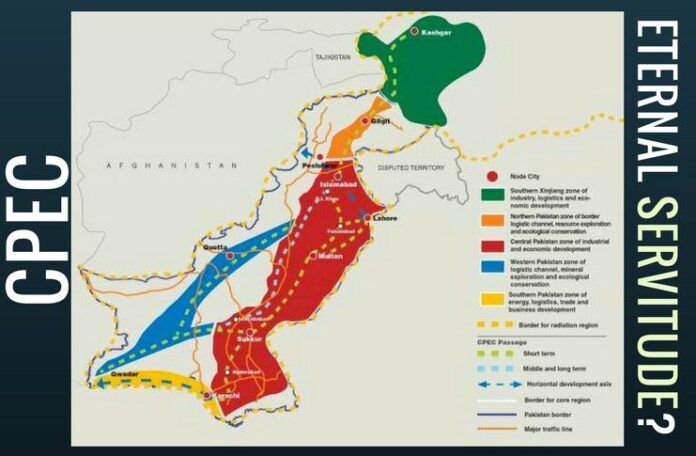
Will the elite of Pakistan take a cut and sign anything?
Pakistan Prime Minister Nawaz Sharif may have received an exceptionally warm welcome when he arrived in Beijing on May 13, 2017, for the Border Road Initiative (BRI) summit, of which the China Pakistan Economic Corridor (CPEC) is the crown jewel, but he may return to a more questioning opinion back home as details of the deal become known. In a piece of spectacular journalism, Khurram Husain of Dawn newspaper (May 15) has revealed details of Chinese intentions and priorities in Pakistan for the next fifteen years. The country’s military mentors will also have much to explain regarding Chinese virtual takeover of Pakistan.
There appear to be two versions of the Long Term Plan; a full version (231 pages) drawn up by the China Development Bank and National Development Reform Commission of the PRC, and a shorter form (30 pages) dated February 2017, which was circulated to the provincial governments for their assent.
The plan makes a grim assessment of Pakistan’s economic situation and accords top priority to gaining access to the full supply chain of the agrarian economy. A major goal is to corner Pakistan’s growing domestic market, especially in cement and household appliances, and finally, internationalisation of the Renminbi (RMB) via greater financial integration and to diversify the risks faced by Chinese enterprises entering Pakistan.
The plan builds on existing market presence of Chinese enterprises such as Haier in household appliances, ChinaMobile and Huawei in telecommunications and China Metallurgical Group Corporation (MCC) in mining and minerals. Gwadar is mentioned as a port of exit for minerals from Balochistan and Afghanistan and as an entrepôt for trade in the Indian Ocean zone from South Africa to New Zealand. There is no mention of China’s external trade being routed through Gwadar. Discussions between the two sides reveal that Islamabad wants work to begin on the Gwadar International Airport, but Beijing wants to complete the Eastbay Expressway.
Two versions of the LTP for CPEC?
Nawaz Sharif’s visit was to finalise the Long Term Plan (LTP) for the CPEC. There appear to be two versions of the Long Term Plan; a full version (231 pages) drawn up by the China Development Bank and National Development Reform Commission of the PRC, and a shorter form (30 pages) dated February 2017, which was circulated to the provincial governments for their assent. Punjab was the sole provincial government to receive the full version of the plan.
Agriculture
The plan envisages leasing 6,500 acres of agricultural land to Chinese firms for demonstration projects that will showcase high yield seeds and irrigation technology, mainly in Punjab. China will control the supply chain, from provision of seeds and inputs like fertiliser, credit and pesticides; Chinese enterprises will operate their own farms, processing facilities for fruits and vegetables and grain. Logistics companies will manage warehousing and distribution network between major cities of Pakistan, with focus on grains, vegetables, and fruits.
…for China, the Xinjiang Prefecture and XPCC, and a profitable entry in Pakistan’s domestic market, are the key.
Storages will be built in Islamabad and Gwadar in the first phase; Karachi, Lahore and another in Gwadar in the second phase, and between 2026-2030, another storage base in Karachi, Lahore and Peshawar. Beijing is offering generous aid to enterprises entering agriculture from various ministries and the China Development Bank. Chinese investors will be helped to connect with senior representatives of the Governments of Pakistan and China.
Vegetable processing plants will be set up in Asadabad, Islamabad, Lahore and Gwadar, with annual output of 20,000 tons; fruit juice and jam plant of 10,000 tons and grain processing of 1 million tons. A cotton processing plant is also planned, with output of 100,000 tons per year.
The Xinjiang Production and Construction Corps will introduce mechanisation and scientific techniques in livestock breeding, development of hybrid varieties and precision irrigation to Pakistan. The firm will connect Kashgar Prefecture in Xinjiang Autonomous Zone, where 50 per cent live in dire poverty, to Pakistan. But the prefecture’s total output in agriculture, forestry, animal husbandry and fishery touched barely $5 billion in 2012, which suggests poor gains for Pakistan.
But for China, the Xinjiang Prefecture and XPCC, and a profitable entry in Pakistan’s domestic market, are the key. There are 10 key areas of engagement and 17 specific projects in this regard.
These include construction of one NPK fertilizer plant “with an annual output of 800,000 tons”. Enterprises will be inducted to lease farm implements like tractors, efficient plant protection machinery, efficient energy saving pump equipment, precision fertilization drip irrigation equipment, and planting and harvesting machinery.
The focus on the textiles industry is limited to yarn and coarse cloth, as the Chinese textiles industry is highly developed.
Chinese enterprises will play a lead role in all fields. They will set up joint ventures, shareholding or acquisition, to cooperate with local enterprises of Pakistan to build a three-level warehousing system (purchase & storage warehouse, transit warehouse, and port warehouse).
The focus on the textile industry is limited to yarn and coarse cloth, as the Chinese textile industry is highly developed. Milk and meat processing plants are also planned.
The section on agriculture concludes that the Government of China will strengthen safety cooperation with key countries, regions and international organisations to jointly prevent and crackdown on terrorist acts that endanger the safety of Chinese overseas enterprises and their staff. Perhaps this is a veiled warning that the abduction of Chinese nationals will not be tolerated.
Industry
The plan partitions Pakistan into three zones: western and northwestern, central and southern, which will have specific industries in designated industrial parks, but few are outlined. The western and northwestern zone (Balochistan and Khyber Pakhtoonwa) will have mineral extraction – chrome ore, gold, diamonds, and marble. China is Pakistan’s largest buyer of processed marble (80,000 tons p.a.). Twelve marble and granite processing sites have been identified from Gilgit and Kohistan in the north to Khuzdar in the south.
To attract investments in the proposed industrial parks, preferential policies would be prepared in areas such as land, tax, logistics and services…
The central zone will have textiles, household appliances, and cement. It proposes cement clusters at Daudkhel, Khushab, Esakhel, and Mianwali, though Pakistan is already surplus in cement capacity.
In the southern zone, the plan moots helping Pakistan to develop petrochemical, iron and steel, harbor industry, engineering machinery, trade processing, and auto and auto parts (assembly) due to the proximity of Karachi and its ports. Khurram Husain notes that this is the only place where the auto industry is mentioned substantively, though it is one of the fastest-growing in Pakistan. Perhaps this is because it is totally dominated by Japanese companies (Toyota, Honda, and Suzuki).
Gwadar, also in the southern zone, “is positioned as the direct hinterland connecting Balochistan and Afghanistan.” As a CPEC entrepôt, it is proposed to be developed as a base of heavy and chemical industries, such as iron and steel/petrochemical. Some Chinese enterprises have begun investment and construction in Gwadar, due to its superior geographical position and cheap shipping costs to import crude oil from the Middle East, iron ore and coking coal resources from South Africa and New Zealand, for onward supply to the local market and to South Asia and the Middle East after processing at the port.
To attract investments in the proposed industrial parks, preferential policies would be prepared in areas such as land, tax, logistics, and services, including land price, enterprise income tax, tariff reduction, and exemption and sales tax rate.
Fibre optics and surveillance
Beijing’s greatest priority since talks on CPEC began is fibre-optic connectivity between China and Pakistan; a memorandum of understanding was signed in July 2013, when CPEC seemed to be merely a road link between Kashgar and Gwadar.
Gwadar will have international cruise clubs offering marine tourists private rooms that would feel as though they were ‘living in the ocean’.
There are many reasons for a terrestrial fibre-optic link with Pakistan, including China’s limited number of submarine landing stations and international gateway exchanges which can inhibit future growth of internet traffic. Then, China’s telecom services to Africa need to be transferred in Europe, so there is hidden danger of overall security. Pakistan has four submarine cables to handle its internet traffic, but only one landing station, which raises security risks.
The plan therefore envisages a terrestrial cable across Khunjerab Pass to Islamabad, and a submarine landing station in Gwadar, linked to Sukkur. From there, the backbone will link the two in Islamabad and all major cities in Pakistan.
The expanded bandwidth will enable terrestrial broadcast of digital HD television (Digital Television Terrestrial Multimedia Broadcasting, DTMB). This is not merely a technological contribution but a “cultural transmission carrier” as future cooperation between Chinese and Pakistani media will help disseminate Chinese culture in Pakistan. There is silence about the nature of this future cooperation and how the system will be used to control the content of broadcast media.
More alarmingly, the plan seeks an electronic monitoring and control system for the border in Khunjerab and to run a “safe cities” project, beginning with Peshawar. This project will deploy explosive detectors and scanners to “cover major roads, crime-prone areas and crowded places … in urban areas to conduct real-time monitoring and 24 hour video recording.” Signals from the surveillance system will be forwarded to a command centre, but there is silence on who will staff the command centre, what they will be monitoring, and who will provide the response.
Tourism and recreation
The plan mentions a long belt of coastal enjoyment industry from Keti Bunder to Jiwani (last habitation before Iran border) and including yacht wharfs, cruise homeports, nightlife, city parks, public squares, theaters, golf courses and spas, hot spring hotels and water sports.
Gwadar will have international cruise clubs offering marine tourists private rooms that would feel as though they were ‘living in the ocean’. Paradoxically, it adds that the coastal vacation products would integrate Islamic culture, historical culture, folk culture and marine culture, whatever that means. Plans are outlined for Ormara, Keti Bunder, Sonmiani, and in the end, the documents seeks “visa-free tourism” for China to Pakistan, but fails to mention reciprocity for Pakistanis visiting China.
Finance and risk
The long term plan drawn up by China Development Bank lays Pakistan’s financial weaknesses threadbare. The main risk is politics and security. The main political factors in Pakistan include competing parties, religion, tribes, terrorists, and Western intervention, with the security situation worst in recent years. There is no mention of the Army and its role in public and economic life. The second risk is inflation, which averaged 11.6 percent over the past 6 years, which indicates a rise of project-related costs and a decline in profits.
But if investment is restricted to US$ 1 billion per annum, at what rate will China build the CPEC, let alone the whole of the Belt Road across 60 countries?
China promises “free and low-interest loans to Pakistan” once the costs of the corridor begin to come in (income), but there is no free ride. Pakistan’s federal and local governments are urged to share financing through the issue of sovereign guarantee bonds and budget outlays. Details about the terms on which Pakistan is expected to repay the loans are withheld, but experience in Sri Lanka and Myanmar shows that it could cause a backlash.
As per IMF, World Bank, and ADB assessments, Pakistan’s economy cannot absorb FDI much above $2 billion per year without giving rise to stresses in its economy. Hence, it recommends that China’s maximum annual direct investment in Pakistan should be around US$1 billion, and Pakistan’s ceiling for preferential loans should be $1 billion and for non-preferential loans no more than $1.5 billion per year.
Then there is exchange rate risk, due to Pakistan’s inability to earn foreign exchange. The plan proposes tripling the size of the swap mechanism between the RMB and Pakistani rupee to 30 billion Yuan, diversifying power purchase payments beyond the dollar into RMB and rupee basket, tapping the Hong Kong market for RMB bonds, and diversifying enterprise loans. The growing role of the RMB in Pakistan’s economy is a major objective of these measures.
But if the investment is restricted to US$ 1 billion per annum, at what rate will China build the CPEC, let alone the whole of the Belt Road across 60 countries? Recovery of investments and extracting profits from the same appears even more elusive.
Note:
1. The area of Gilgit-Baltistan is disputed territory as it was part of the kingdom of Kashmir, which acceded to India.
2. Text in Blue points to additional data on the topic.
- Plagiarism with Pride - November 10, 2018
- “Hindu-ness is the essence of India” – RSS Sarsanghachalak - September 20, 2018
- Lacunas persist in Kathua story - May 5, 2018











Personally i feel it is an over ambitious project involving Gilgit,Pok, and Balochistan,all three of them are simmering. With India not joining the Obor ,and cozying up to Japan to opt for a democratic sea route with a string of ports it is doubtful weather It will achieve the desired effects planned for. As has been pointed out it is doubtful to pass through without lubricating the wheels of machinery . Will Islam accept colonization and be under the Chinese thumb ?Then how will uncle Sam behave to morrow ?He is changing his colours so fast that i am loosing track of vibgyor.I will abide by your advice madam.”Have Patience”Lovely analysis.
Many thanks to Sandhya Jain for her in-depth analysis of the CPEC projects, we Baloch think CPEC nothing more than a full-fledged exploitation of Baluchistan’s mineral resources and means of transfering them to china and Punjab… 🙁
Good, either Pak would be cleansed of jehadis or China would get entangled with a failing State – either way it is good for India!
China is colonising Pakistan. What are the implications for India?
India Should Worry On What Terms Modi Has Signed LEMOA